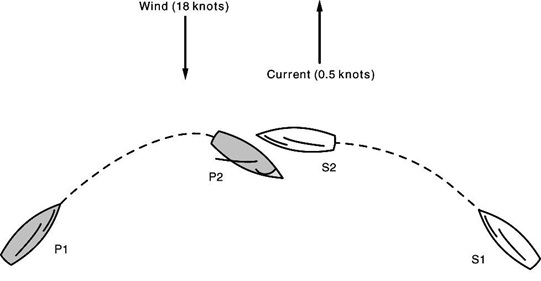



CASE 92
Rule 14, Avoiding Contact
Rule 16.1, Changing Course
Rule 16.2, Changing Course
When a right-of-way boat changes course, the keep-clear
boat is required to act only in response to what the right-ofway
boat is doing at the time, not what the right-of-way boat
might do subsequently.
Facts
On a windward leg in winds of 18 knots, S and P approached each other on
opposite tacks. P bore off to avoid S. S also bore off, and P continued
bearing off in order to pass astern of S. S also continued to bear off, heeling
further to leeward as a result. There was contact between the masts and
rigging of the two boats and P’s mast was broken.
The protest committee disqualified S for breaking rule 16 and she appealed.

Decision
S’s appeal is dismissed. The protest committee’s decision to disqualify her
is upheld, under rules 14, 16.1 and 16.2.
Initially the boats were on collision courses. P bore away to keep clear of S
as required by rule 10. The written facts and the diagram established that P
would have kept clear of S by passing to leeward of her if S had not changed
her course. However, S bore away, causing P to immediately bear away still
further to be able to continue keeping clear. By changing course as she did,
S broke rule 16.2.
S continued changing course, at an increasing rate of turn. At some time
before the collision, nothing that P could have done in a seamanlike way
would have made it possible for her to keep clear. Therefore, by continuing
to change course S also broke rule 16.1.
In addition, S broke rule 14 and must be penalized under that rule because,
as the right-of-way boat, she failed to avoid contact that caused damage
when it was reasonably possible for her to have done so.
S argued that P could have tacked or gybed, and claimed that this was P’s
obligation. This is a misunderstanding of the obligations of a keep-clear boat
under rule 10 and other right-of-way rules. A keep-clear boat is required to
act only in response to what a right-of-way boat is doing at the time, not
what the right-of-way boat might do subsequently. Until she was unable to
do so, P did as she was required, keeping clear by changing course in such
a way that S, had she not continued to bear away towards P, would have had
‘no need to take avoiding action’ (see the definition Keep Clear).
In failing to keep clear, P broke rule 10, but that was a consequence of S’s
breaches of rules 16.1 and 16.2. Therefore P was exonerated by either rule
43.1(a) or rule 43.1(b). P was not able to avoid contact after it became clear
that S was failing to give her room to keep clear; therefore P did not break
rule 14.
USA 1997/75






